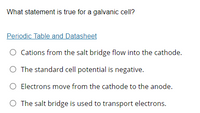
Chemistry
10th Edition
ISBN: 9781305957404
Author: Steven S. Zumdahl, Susan A. Zumdahl, Donald J. DeCoste
Publisher: Cengage Learning
expand_more
expand_more
format_list_bulleted
Question

Transcribed Image Text:What statement is true for a galvanic cell?
Periodic Table and Datasheet
Cations from the salt bridge flow into the cathode.
O The standard cell potential is negative.
O Electrons move from the cathode to the anode.
O The salt bridge is used to transport electrons.
Expert Solution
This question has been solved!
Explore an expertly crafted, step-by-step solution for a thorough understanding of key concepts.
Step by stepSolved in 2 steps

Knowledge Booster
Learn more about
Need a deep-dive on the concept behind this application? Look no further. Learn more about this topic, chemistry and related others by exploring similar questions and additional content below.Similar questions
- Please don't provide handwritten solutionarrow_forwardHow is the amount of current flowing through an electrolytic cell related to the amount of product produced in the redox reaction? Match the items in the left column to the appropriate blanks in the sentences on the right. multiplied coulombs Avogadro's 1 mol Faraday's 1g ampers 6.022 x 10¹ mol volts divided The number of moles of electrons that have flowed in a given electrolysis cell can be determined by measuring the total charge that has flowed through the cell. If the amount of current flowing through the cell is by the time that the current flowed, the total charge that passed through the cell in that time can be found. The relationship between charge and the number of moles of electrons constant, which corresponds to the charge in is given by of of electrons. These relationships are used to solve problems involving the stoichiometry of electrolytic cells. Reset Helparrow_forwardQuestions 20 and 21 refer to the following information. Galvanic Cell Cell Diagram E°cell (Volts) Mg | Mg2(1.0 M) || Pb*2(1.0 M) | Pb 1 2.24 Zn | Zn(1.0 M) || Pb*2(1.0 M) | Pb 2 0.63 Mg | Mg*(1.0 M) || Zn*2(1.0 M) | Zn 3 The chemical reaction occurring in first galvanic cell is: Mg + Pb*2 → Mg+2 + Pb 21. If the concentration of Mg+2 is changed from 1.0 M to 3.0 M in the galvanic cells above, what will happen to the observed cell voltages in galvanic cells 1 and 3? (A) The voltage in both galvanic cells 1 and 3 will increase. (B) The voltage will decrease in both galvanic cells 1 and 3. (C) The voltage in galvanic cell 1 will increase and will decrease in galvanic cell 3 (D) The voltage in galvanic cell 3 will increase and will decrease in galvanic cell 1. 22. Consider a voltaic cell based on these half-cells. Ag (aq) +e → Ag/s) Cd (aq) + 2e → Cd¢s) E* = +0.80 V E = -0.40 V Identify the anode and give the voltage of this cell under standard conditions. (A) Ag; Ecell = 0.40 V (B) Ag;…arrow_forward
- A certain metal M forms a soluble nitrate salt M(NO3)₂. Suppose the left half cell of a galvanic cell apparatus is filled with a 1.00 M solution of M 2 M(NO3), and the right half cell with a 0.500 mM solution of the same substance. Electrodes made of M are dipped into both solutions and a voltmeter is connected between them. The temperature of the apparatus is held constant at 40.0 °C. Which electrode will be positive? O left O right What voltage will the voltmeter show? Assume its positive lead is connected to the positive electrode, 0 Be sure your answer has a unit symbol, if necessary, and round it to 2 significant digits. 0 Xarrow_forwardWhich of the following statements is(are) true for all galvanic cells? 1. Reduction occurs at the cathode. II. The anode gains mass during discharge (note: this means operation of the cell.) III. The voltage is less than or equal to zero. O only I O only III O only II O L I, and II O Il and IIarrow_forwardis an electrochemical cell in which a spontaneous redox reaction takes place. Electrolytic cell O Concentration cell O Voltaic cell O Batteryarrow_forward
- You are a bioengineer designing a new type of pacemaker. Which type of Galvanic cell would be best for you to use in this new device?arrow_forwardWhat is the name given to the apparatus that connects the two solutions by a conducting medium through where the cations and anions can move from one half-cell to the other? a) cathode b) electrode c) galvanic cell d) salt bridge e) fuel cell D C A OEarrow_forwardWhat is the corresponding standard cell potential for the fllowing standard free energy change and electron stoichiometry value? 12 kJ/mol, n=3 A) -0.1242 V B) 0.0414 V c) -0.0414 V 96,485 Varrow_forward
arrow_back_ios
arrow_forward_ios
Recommended textbooks for you
 ChemistryChemistryISBN:9781305957404Author:Steven S. Zumdahl, Susan A. Zumdahl, Donald J. DeCostePublisher:Cengage Learning
ChemistryChemistryISBN:9781305957404Author:Steven S. Zumdahl, Susan A. Zumdahl, Donald J. DeCostePublisher:Cengage Learning ChemistryChemistryISBN:9781259911156Author:Raymond Chang Dr., Jason Overby ProfessorPublisher:McGraw-Hill Education
ChemistryChemistryISBN:9781259911156Author:Raymond Chang Dr., Jason Overby ProfessorPublisher:McGraw-Hill Education Principles of Instrumental AnalysisChemistryISBN:9781305577213Author:Douglas A. Skoog, F. James Holler, Stanley R. CrouchPublisher:Cengage Learning
Principles of Instrumental AnalysisChemistryISBN:9781305577213Author:Douglas A. Skoog, F. James Holler, Stanley R. CrouchPublisher:Cengage Learning Organic ChemistryChemistryISBN:9780078021558Author:Janice Gorzynski Smith Dr.Publisher:McGraw-Hill Education
Organic ChemistryChemistryISBN:9780078021558Author:Janice Gorzynski Smith Dr.Publisher:McGraw-Hill Education Chemistry: Principles and ReactionsChemistryISBN:9781305079373Author:William L. Masterton, Cecile N. HurleyPublisher:Cengage Learning
Chemistry: Principles and ReactionsChemistryISBN:9781305079373Author:William L. Masterton, Cecile N. HurleyPublisher:Cengage Learning Elementary Principles of Chemical Processes, Bind...ChemistryISBN:9781118431221Author:Richard M. Felder, Ronald W. Rousseau, Lisa G. BullardPublisher:WILEY
Elementary Principles of Chemical Processes, Bind...ChemistryISBN:9781118431221Author:Richard M. Felder, Ronald W. Rousseau, Lisa G. BullardPublisher:WILEY

Chemistry
Chemistry
ISBN:9781305957404
Author:Steven S. Zumdahl, Susan A. Zumdahl, Donald J. DeCoste
Publisher:Cengage Learning

Chemistry
Chemistry
ISBN:9781259911156
Author:Raymond Chang Dr., Jason Overby Professor
Publisher:McGraw-Hill Education

Principles of Instrumental Analysis
Chemistry
ISBN:9781305577213
Author:Douglas A. Skoog, F. James Holler, Stanley R. Crouch
Publisher:Cengage Learning

Organic Chemistry
Chemistry
ISBN:9780078021558
Author:Janice Gorzynski Smith Dr.
Publisher:McGraw-Hill Education

Chemistry: Principles and Reactions
Chemistry
ISBN:9781305079373
Author:William L. Masterton, Cecile N. Hurley
Publisher:Cengage Learning

Elementary Principles of Chemical Processes, Bind...
Chemistry
ISBN:9781118431221
Author:Richard M. Felder, Ronald W. Rousseau, Lisa G. Bullard
Publisher:WILEY